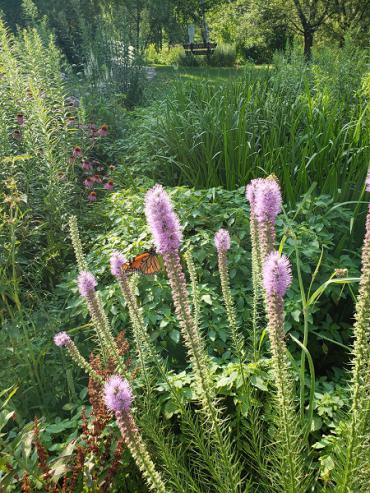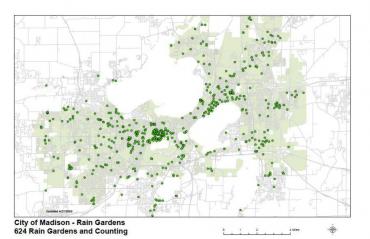Stuck at Home? Plant a Rain Garden, Help City Reach 1,000 Rain Garden Goal
While our community remains at home during the COVID-19 Stay at Home Order until May 24, the Engineering Division invites all residents to take part in reaching its renewed 1,000 rain garden goal. When at home planning, planting and maintaining a rain garden, all residents should practice proper social distancing, per the Stay at Home Order.
A rain garden is a garden of native shrubs, perennials, and flowers planted in a shallow depression, which, sometimes, is built on a natural slope. Rain gardens are often designed to capture and infiltrate water into the ground. A rain garden is a great option for stormwater management as it temporarily holds and soaks in rainwater runoff that flows from roofs, driveways, patios or lawns.
As of April 21, 2020, the City has 624 rain gardens recorded on its rain garden map.
If you have a rain garden, and want it included on a future interactive map the City is working on, email the photo to engineer@cityofmadison.com with the location. A point representing each rain garden will be added to the map, but addresses and information will remain private.
Building a Rain Garden
Benefits to resident
A rain garden can reduce risks of flooding in your neighborhood and the City. A rain garden is able to direct water away from your home and directly into the groundwater. As more rain gardens are installed, the pressure on the stormwater management pipes can be reduced. This lessens the risk of flooding during extreme storm events.
A properly designed rain garden will never attract breeding mosquitoes. A properly designed rain garden infiltrates water from storm events in less than two days. Mosquitoes need 10-14 days of standing water to successfully complete their reproduction cycle.
Benefits to environment
Rain gardens help Madison lakes. Rain gardens can reduce sediment loads and nutrient loads such as nutrient-loaded fertilizers. These are all things that at times wash off driveways, parking lots, lawns and streets during storm events. By directing runoff into rain gardens to be filtered rather than directly into the lakes, the risk of nutrient-forced algae blooms, health risks from poor water quality, and habituate degradation lower.
A rain garden, particularly one with native plants, can attract beneficial birds, hummingbirds, butterflies and bees. Monarch butterflies can thrive when rain gardens have milkweed and blazing star species. Birds can eat the native plant seeds during the fall and winter.
Method and Materials
Careful planning and construction is important for a fully functional rain garden. Typically you’ll need to measure height, width and depth, identify your soil, plan your plantings and decide location in your yard. The Wisconsin Department of Natural Resources breaks down all method and materials in its helpful guide. Before digging, always call Digger’s Hotline at 811. Failure to call Digger’s Hotline is against the law and both potentially dangerous and costly.
When buying materials, abide by social distancing requirements, and if possible order online and pick up with no contact. When planting, exercise the same caution with social distancing.
Cost
Building a rain garden can be as expensive or inexpensive a resident wants it to be. Potential costs include labor, plants, mulch and tools. Residents may hire a company to construct the rain garden or do it on their own.
There are number of local native plant nurseries that also sell native plant plugs.
Resources
Guide: Build your Rain Garden for $100 or less
Wisconsin Department of Natural Resources Guide: How to build a raingarden
Everyday Engineering Podcast Episode: Rain, Rain Go in My Garden
Map: Current Rain Garden locations in Madison
Contacts
- Hannah Mohelnitzky, Public Information Officer, City of Madison Engineering Division, 608-669-3560, hmohelnitzky@cityofmadison.com

